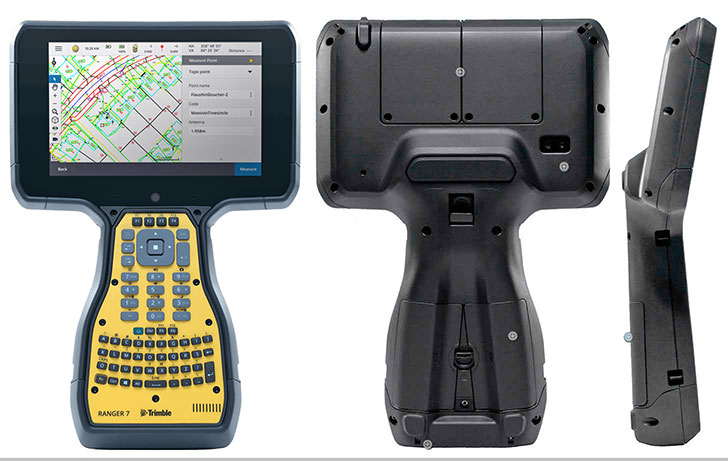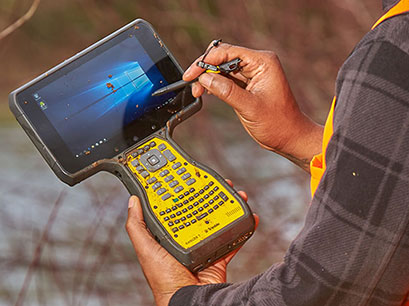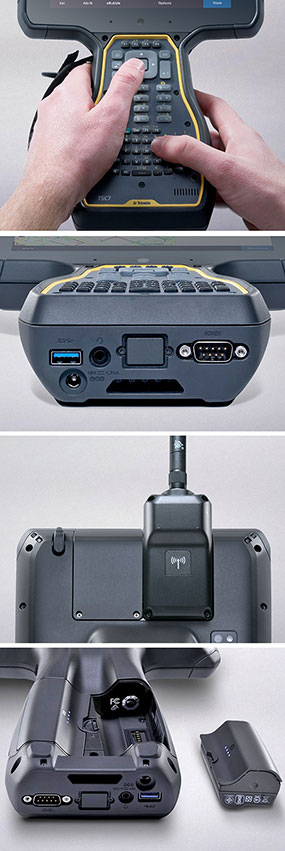

Why the display of a mobile device is so important (Field Technologies Magazine, September 2013)
Every computer a mobile computer (GPS World Magazine, July 2013)
|

|

|
|
|
Trimble Ranger 7
Integrating Windows 10 tablet and flashlight-style keypad into something new and different
(by Conrad H. Blickenstorfer)
Most know Trimble for its GPS products and expertise. The company integrates all sorts of positioning technologies (GPS, laser, optical and inertial) with application software, wireless communications, and services to provide complete commercial and industrial solutions. But Trimble also offers robust rugged mobile computing hardware to go with the company's large variety of positioning technologies and applications. The Trimble Ranger 7, introduced Spring 2018, is a prime (and very interesting) example.

Trimble describes the Ranger 7 as a fully-rugged field handheld computer for professional organizations that know they can't afford to take shortcuts, and that the Ranger 7, combined with specialized software, defines the next generation of data collection and computing for mobile workers.
And the Ranger 7 is new and different indeed. While a first look at a picture of the device may suggest a standard flashlight-style handheld with a landscape display, the Ranger 7 is a very unique animal. What Trimble did here is take a 7-inch tablet and merge it with a large handle that includes both a small QWERTY keypad as well as a separate numeric keypad and function keys.
As a result, the Ranger 7 is much larger than your standard flashlight handheld. It can be used like a handheld, though at 3.1 pounds it's a big, hefty one. It can also be used as a tablet, as its 7-inch screen sports 10-point capacitive multi-touch. That means users can tap, pan, zoom and pinch like on any smartphone or consumer tablet. Or the Ranger 7 can be placed on a desk and used like a laptop, sort of.
Trimble says the device was designed based on customer feedback. This suggests that customers like the handheld flashlight-style form factor but wanted a much bigger screen and a more powerful computer. Trimble obliged and combined all of this into one device. As a result, the Ranger 7 measures 11.8 x 8.2 x 2.8 inches and is quite unlike anything else out there.
Great procap display
The Trimble Ranger 7's tablet size display offers more screen real estate than any traditional handheld. It measures 7 inches diagonally and offers full 1280 x 800 pixel resolution, making for 16:10 aspect ratio and a sharp 216 pixels per inch.
216 ppi is about the same pixel density as a Microsoft Surface Pro 3 or Apple's retina iMacs and MacBooks. Its sharpness makes the Ranger 7 display pleasant to use and work on. When it comes to mapping, GIS and virtually any positioning technology, sharper is better, and the Trimble Ranger 7 certainly delivers. Sharpness is complemented by perfect horizontal and vertical viewing angles. Colors, brightness and contrast remain true and unchanged when viewed from above, below, left and right.
The display is scratch-resistant, uses anti-reflective coating, and has a strong backlight that can generate luminance up to more than 650 nits (a standard laptop has around 200 nits, a bright consumer tablet 400 to 500 nits). A stylus (of unspecified technology) stores inside the unit's housing and includes a lanyard that can be attached to either side of the unit.
The illuminated alphanumeric keypad comes with QWERTY or ABCD layout, four-way directional keys, laid out in a QWERTY or ABCD design, numeric keypad and six physical function keys. All keys provide tactile and audio feedback.
Powerful, versatile mobile platform
Unlike the vast majority of flashlight-style handhelds that run either Android or the older Microsoft Embedded Handheld operating system, the Ranger 7 runs full Windows 10 on an Intel Pentium N4200 processor. The N4200 is a modern quad-core design of Intel's "Apollo Lake" series of notebook and tablet CPUs. Apollo Lake uses an Atom-based x86 microarchitecture named Goldmont, as well as a graphics core using the same Gen9 architecture as is in Intel's powerful 6th generation "Skylake" core processors.
The Pentium N4200 runs at a base frequency of 1.1GHz and can reach burst speeds up to 2.5GHz. Its thermal design power is six watts, significantly lower than the 15 watts of most current ultra-low voltage Intel Core processors. That means no fan is needed.
There is 8GB of modern, efficient LPDDR4 SDRAM, and mass storage comes in the form of 64GB of eMMC Solid State Disk. There are no other capacity options but storage can be augmented with up to 2TB of micro-SDXC card.
Rugged tablets usually don't have a lot of onboard connectors because space and weight are at a premium. The Trimble Ranger 7 offers a 3.5mm audio jack, a power jack, a DB9 serial port, and a single standard USB 3.1 port to provide office connectivity to monitors, mouse, keypad, LAN, etc.
On the wireless side, there's dual-band 802.11a/b/g/n WiFi, Bluetooth versions 2.1 + EDR and also 4.1, GNSS, as well as 3G and worldwide LTE in regions where it is available. The Ranger 7 has an 8MP autofocus rear camera with flash, and a fixed-focus 2MP front camera.
For power, the Ranger 7 accommodates dual removable and hot-swappable 21 watt-hour Li-Ion batteries in its handle. Trimble quotes 6-10 hours of battery life with continuous use.
Tough and rugged
Like all Trimble mobile computers, the Ranger 7 is exceptionally tough and rugged. The Trimble Ranger 7 tablet has a very wide -22 and 140 degrees Fahrenheit operating temperature range. It can survive the obligatory 26 drops from four feet onto plywood over concrete.
The device sports impressive IP68 ingress protection rating, where the 6 stands for total protection against dust, and the 8 for protection against full immersion of the unit down to one meter for two hours. Note that the rugged mobile computing industry gold standard is IP67 protection; the Trimble Ranger 7 does better.
Based on our experience with prior Trimble products, we expect the Ranger 7 to be exceptionally well made and entirely capable of performing duty in tough working environments.
Bottom Line: Trimble Ranger 7
With the Ranger 7, Trimble adds an interesting, unique field computer/solution for large scale field data capture in nearly any industry and application. By merging a modern Windows 10 tablet with a spacious traditional keypad handle, Trimble seeks to address the needs of professionals who run dedicated software such as Trimble Access 2018 and Trimble Sync Manager, but also like the speedy, effortless data entry afforded by a flashlight-style handle with keypads.
|
|
|
 Specifications Trimble Ranger 7
Specifications Trimble Ranger 7
|
|
Status
|
Added 4/2018
|
|
Form-factor
|
Rugged tablet with keypad
|
|
Processor
|
Quad-core Intel "Apollo Lake" Pentium N4200 processor
|
CPU Speed
|
1.1GHz (2.5GHz turbo)
|
Graphics
|
Intel HD Graphics 505, 200/750MHz
|
Standard/Max RAM
|
8GB LPDDR4 SDRAM
|
OS
|
Windows 10
|
Disk/drive
|
64GB eMMC solid state disk
|
Card slots
|
1 x MicroSIM card, 1 x microSDXC (up to 2TB), 2 x Trimble EMPOWER module slots
|
Display type
|
Sunlight readable TFT, 650+ nits
|
Display size/res
|
7-inch/1280 x 800 pixel, 216 ppi
|
Digitizer/pens
|
10-point capacitive multi-touch
|
Keyboard/scale
|
Backlit QWERTY or ABCD, numeric key block, Fn keys (6 physical + 6 2nd function Fn keys)
|
Housing
|
Glass-fiber reinforced resin with integrated drop bumpers
|
Operating Temp
|
-22° to 140°F (-30° to 60°C)
|
Shock
|
MIL-STD 810G 516.6 Category IV: multiple 4-foot drops
|
Sealing
|
IP68 (2 hours down to 1 meter)
|
Humidity
|
90 % RH temp cycle -20 °C/60 °C (-4 °F/140 °F) MIL-STD-810G, Method 507.5, Procedure II
|
Salt Fog test
|
Unknown
|
Altitude
|
Operational at 4,572 m (15,000 ft), MIL-STD-810G,
Method 500.5, (Altitude) Procedure I, II & III
|
Solar exposure
|
Survives prolonged solar exposure, MIL-STD810G Method 505.5, Procedure II, Solar Exposure
|
EMI/EMC
|
Unknown
|
Certifications
|
required approvals by country
|
Size (WxHxD)
|
11.8 x 8.1 x 1.8 inches (300 x 205 x 47 mm)
|
Weight
|
2.3 lbs. (1.05 kg) with standard battery
|
Power
|
Dual removable, hot-swappable 21 watt-hour Li-Ion batteries ("continuous usage 6-10 hours")
|
Sensors
|
3-axis accelerometer, magnetic, ambient light, gyroscope
|
Camera
|
Rear camera 8 MP autofocus with flash; Front camera 2 MP fixed-focus
|
Interface
|
1 x USB 3.1, 3.5mm audio, RS232 Serial, power
|
Wireless
|
802.11a/b/g/n/ac WiFi, Bluetooth 4.2 (incl. BTLE), Sierra Wireless EM7455 or EM7430 (worldwide LTE in regions where it is available, and compatible with 3G networks AT&T and Verizon certified), GNSS
|
List price
|
Inquire
|
Product page
|
Trimble Ranger 7 webpage
|
Brochure
|
 Trimble Ranger 7 brochure Trimble Ranger 7 brochure
|
Data sheet
|
 Trimble Ranger 7 data sheet Trimble Ranger 7 data sheet
|

|
|
|
|






